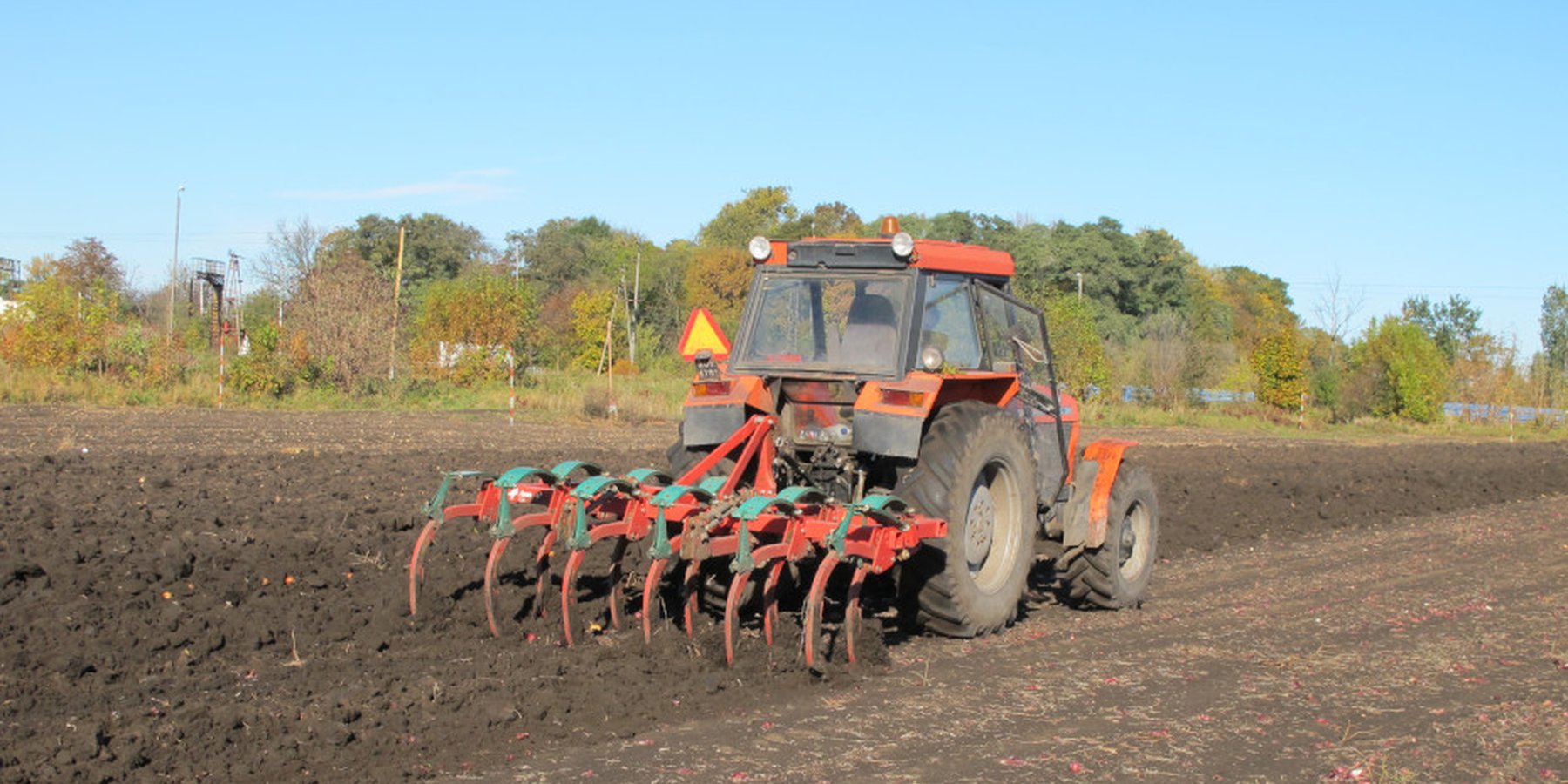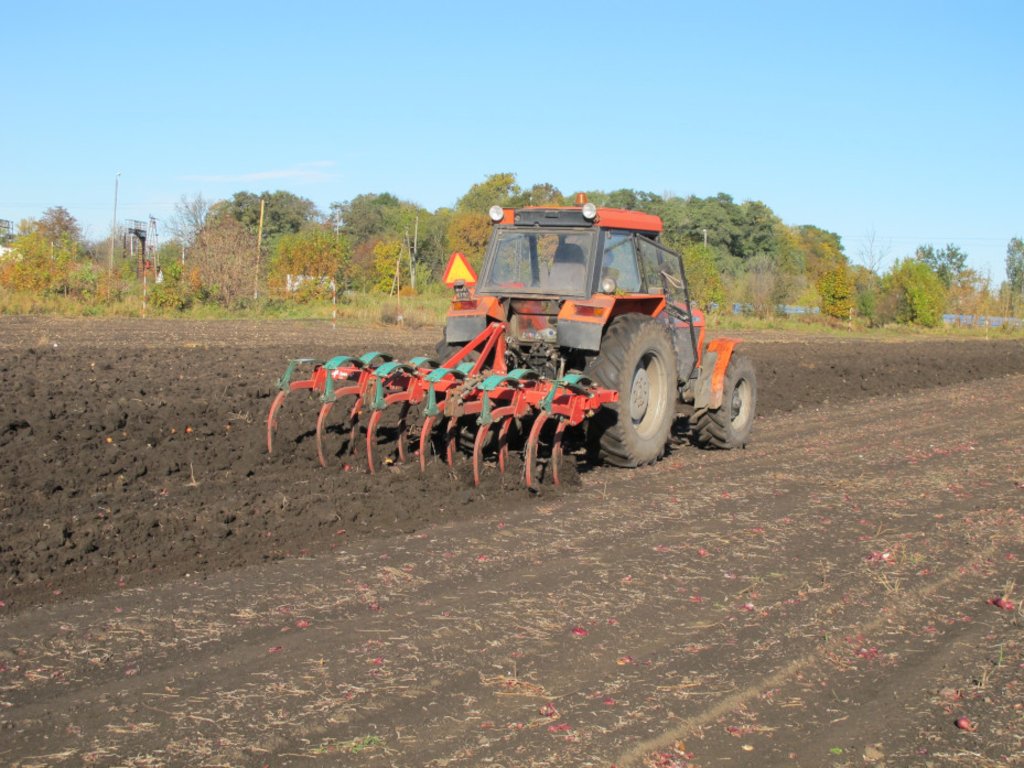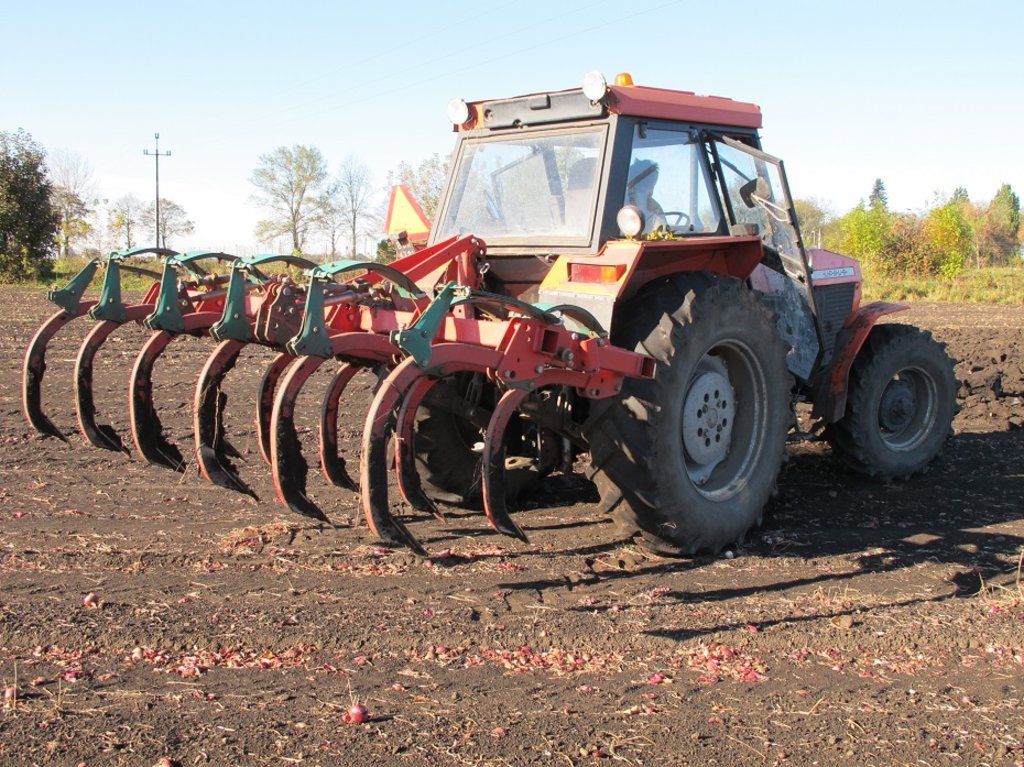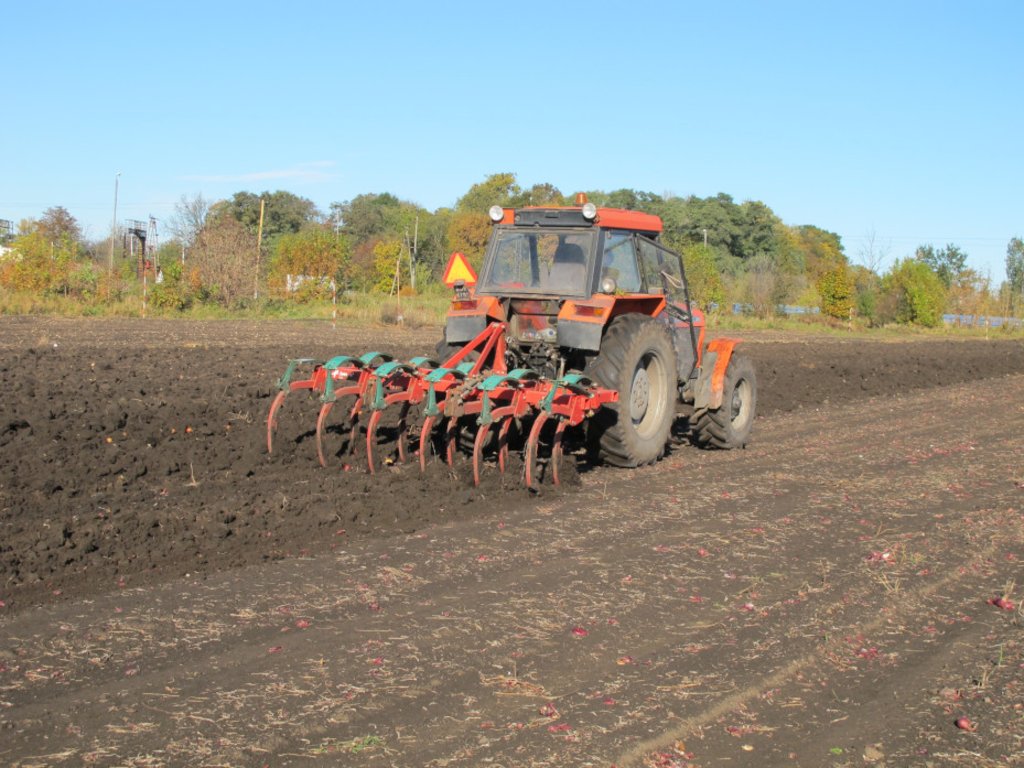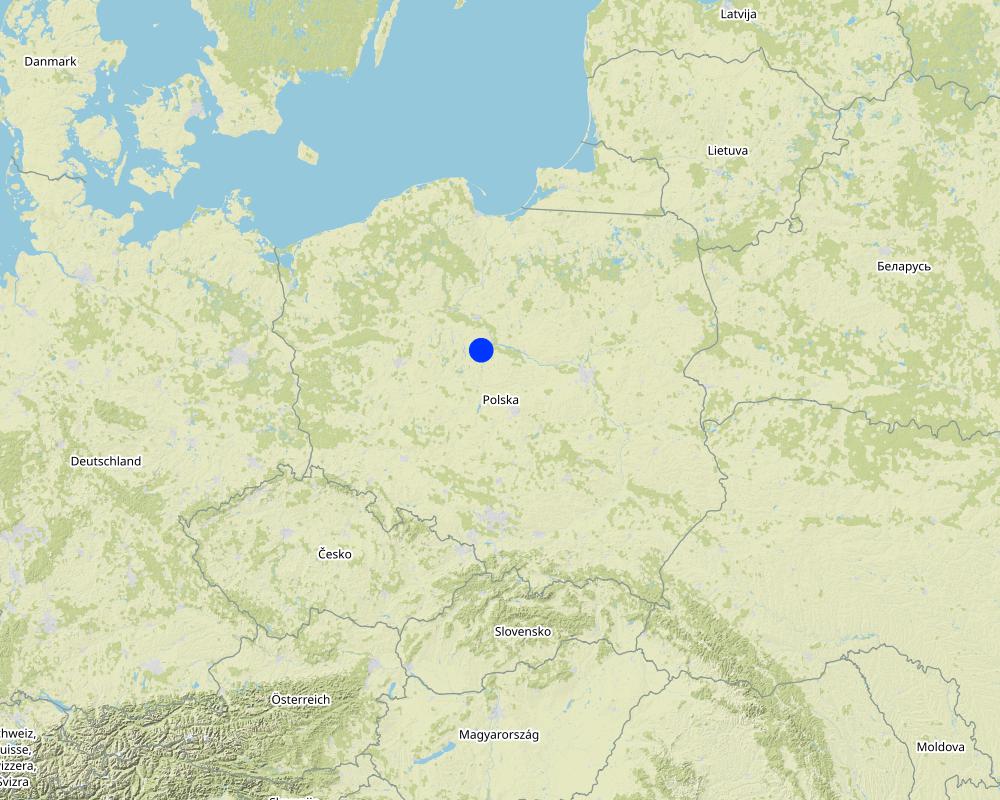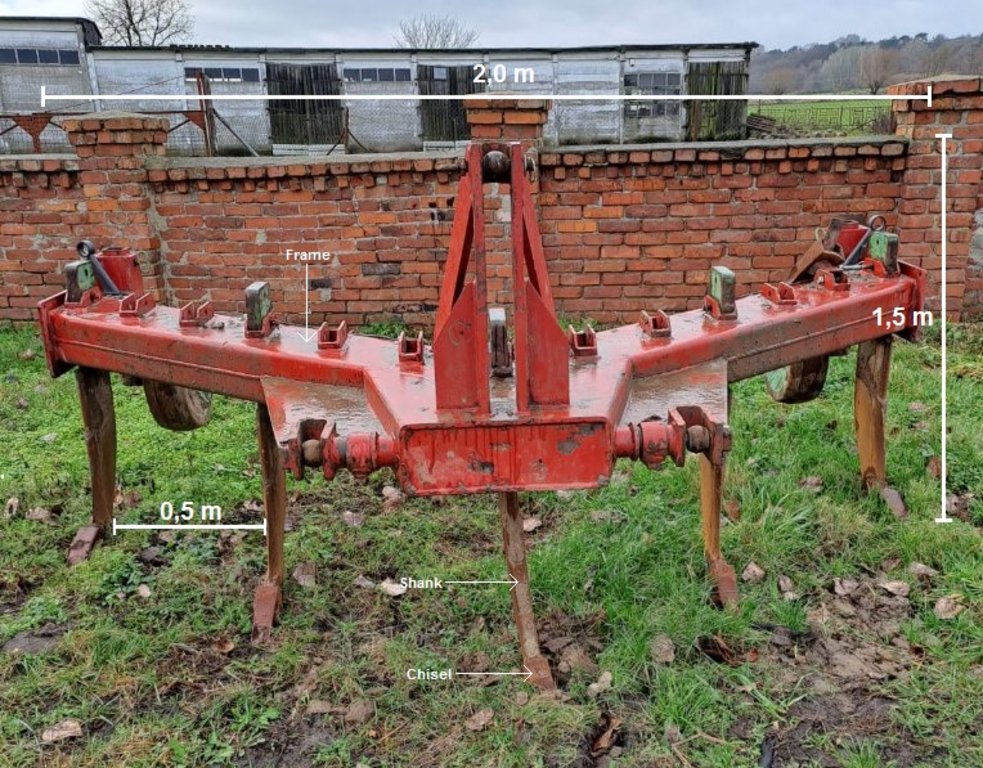Subsoiling [โปแลนด์]
- ผู้สร้างสรรค์:
- การอัพเดท:
- ผู้รวบรวม: Tymoteusz Bolewski
- ผู้เรียบเรียง: Marek Giełczewski
- ผู้ตรวจสอบ: William Critchley, Rima Mekdaschi Studer
Głęboszowanie
technologies_6250 - โปแลนด์
ดูส่วนย่อย
ขยายทั้งหมด ย่อทั้งหมด1. ข้อมูลทั่วไป
1.2 รายละเอียดที่ติดต่อได้ของผู้รวบรวมและองค์กรที่เกี่ยวข้องในการประเมินและการจัดเตรียมทำเอกสารของเทคโนโลยี
วิทยากรหลัก
ผู้ใช้ที่ดิน:
- Tadeusz
Self-employed farmer
โปแลนด์
ผู้ใช้ที่ดิน:
- Marcin
Self-employed farmer
โปแลนด์
ผู้ใช้ที่ดิน:
- Jaroslaw
medium scale enterprise
โปแลนด์
ชื่อของโครงการซึ่งอำนวยความสะดวกในการทำเอกสารหรือการประเมินเทคโนโลยี (ถ้าเกี่ยวข้อง)
OPtimal strategies to retAIN and re-use water and nutrients in small agricultural catchments across different soil-climatic regions in Europe (OPTAIN)ชื่อขององค์กรซึ่งอำนวยความสะดวกในการทำเอกสารหรือการประเมินเทคโนโลยี (ถ้าเกี่ยวข้อง)
Institute of Technology and Life Sciences – National Research Institute, Poland (ITP) - โปแลนด์1.3 เงื่อนไขการใช้ข้อมูลที่ได้บันทึกผ่านทาง WOCAT
ผู้รวบรวมและวิทยากรหลักยอมรับเงื่อนไขเกี่ยวกับการใช้ข้อมูลที่ถูกบันทึกผ่านทาง WOCAT:
ใช่
1.4 การเปิดเผยเรื่องความยั่งยืนของเทคโนโลยีที่ได้อธิบายไว้
เทคโนโลยีที่ได้อธิบายไว้นี้เป็นปัญหาของความเสื่อมโทรมโทรมของที่ดินหรือไม่ จึงไม่ได้รับการยอมรับว่าเป็นเทคโนโลยีเพื่อการจัดการที่ดินอย่างยั่งยืน:
ไม่ใช่
แสดงความคิดเห็น:
-
1.5 Reference to Questionnaire(s) on SLM Approaches (documented using WOCAT)
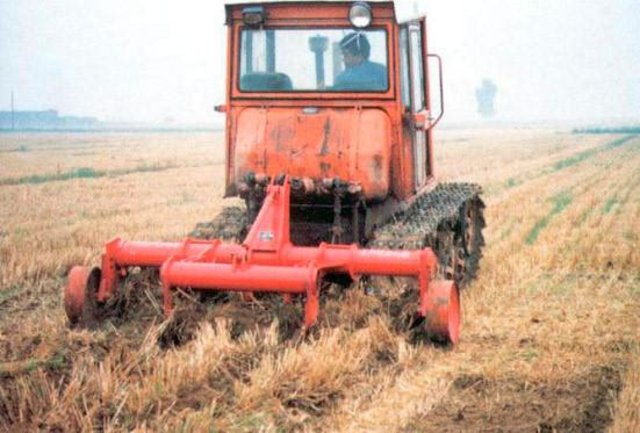
Subsoiling [จีน]
Subsoiling with mulching is one of the conservative tillage using subsoiling plough to loose subsoils with surface soil undisturbed.
- ผู้รวบรวม: Zhanguo Bai
2. การอธิบายลักษณะของเทคโนโลยี SLM
2.1 การอธิบายแบบสั้น ๆ ของเทคโนโลยี
คำจำกัดความของเทคโนโลยี:
Subsoiling is defined as tillage below a depth of about 35-40 cm which doesn't invert the soil. It breaks up compacted layers to improve rooting and infiltration. Subsoiling is not needed on light soils, because these are rarely at risk of compaction.
2.2 การอธิบายแบบละเอียดของเทคโนโลยี
คำอธิบาย:
Subsoiling is carried out on arable land. Subsolier is pulled by a tractor and chisels (tines) break up a compacted layer below the surface. Subsoiling disturbs this dense layer and loosens the soil. This treatment improves air-water relations in the soil. The depth of subsoiling can be adjusted. On heavier soils, deeper subsoiling may be necessary. The farmer surveyed (who has a medium sized enterprise of about 400 ha) subsoils at a depth of 40-45 cm. Subsoiling is used especially for root crops such as sugar beet - and for other crops to a lesser extent, depending on the needs and condition of the soil. It is possible to adjust the spacing of the chisels (tines) and the power of the tractor. An average spacing between the chisels is 50 cm. A 200 horsepower tractor is able to pull a five-tine subsoiler. If time permits, the whole field should be subsoiled. Subsoiling takes quite a long time (about 10 ha per day). This technology is required every year when sugar beet is planted. In other fields, only machinery tracks and headlands (where the machine turns) should be subsoiled every year. Subsoiling is often used after harvest and before other field operations such as ploughing etc. On average, due to crop rotation, the whole field is only subsoiled once every four years. Subsoiling is a form of tillage which can be used instead of traditional ploughing to loosen soil without inverting it: thus it can form part of a reduced tillage system.
2.3 รูปภาพของเทคโนโลยี
2.4 วีดีโอของเทคโนโลยี
ความคิดเห็น/อธิบายสั้นๆ:
-
สถานที่:
-
ชื่อผู้ถ่ายวีดีโอ:
-
2.5 ประเทศภูมิภาค หรือสถานที่ตั้งที่เทคโนโลยีได้นำไปใช้และได้รับการครอบคลุมโดยการประเมินนี้
ประเทศ:
โปแลนด์
ภูมิภาค/รัฐ/จังหวัด:
Kuyavian-Pomeranian Voivodeship
ข้อมูลจำเพาะเพิ่มเติมของสถานที่ตั้ง :
Southern part of the region called Kujawy
ระบุการกระจายตัวของเทคโนโลยี:
- กระจายไปอย่างสม่ำเสมอในพื้นที่
If precise area is not known, indicate approximate area covered:
- 1-10 ตร.กม.
Is/are the technology site(s) located in a permanently protected area?
ไม่ใช่
แสดงความคิดเห็น:
Most often used as a part of conventional tillage technology, as an additional activity. Subsoiling is performed on about 25% of total farm area.
Map
×2.6 วันที่การดำเนินการ
ถ้าไม่รู้ปีที่แน่นอน ให้ระบุวันที่โดยประมาณ:
- 10-50 ปี
2.7 คำแนะนำของเทคโนโลยี
ให้ระบุว่าเทคโนโลยีถูกแนะนำเข้ามาอย่างไร:
- ด้วยการริเริ่มของผู้ใช้ที่ดินเอง
- ในช่วงการทดลองหรือการทำวิจัย
ความคิดเห็น (ประเภทของโครงการ เป็นต้น) :
-
3. การจัดประเภทของเทคโนโลยี SLM
3.1 วัตถุประสงค์หลักของเทคโนโลยี
- ปรับปรุงการผลิตให้ดีขึ้น
- ลด ป้องกัน ฟื้นฟู การเสื่อมโทรมของที่ดิน
- อนุรักษ์ระบบนิเวศน์
3.2 ประเภทของการใช้ที่ดินในปัจจุบันที่ได้นำเทคโนโลยีไปใช้
Land use mixed within the same land unit:
ไม่ใช่

พื้นที่ปลูกพืช
- การปลูกพืชล้มลุกอายุปีเดียว
Annual cropping - Specify crops:
- cereals - barley
- cereals - maize
- cereals - oats
- cereals - wheat (spring)
- cereals - wheat (winter)
- root/tuber crops - sugar beet
- vegetables - root vegetables (carrots, onions, beet, other)
จำนวนของฤดูเพาะปลูกต่อปี:
- 1
Is intercropping practiced?
ไม่ใช่
Is crop rotation practiced?
ใช่
3.3 Has land use changed due to the implementation of the Technology?
Has land use changed due to the implementation of the Technology?
- No (Continue with question 3.4)
3.4 การใช้น้ำ
การใช้น้ำของที่ดินที่มีการใช้เทคโนโลยีอยู่:
- น้ำฝนร่วมกับการชลประทาน
3.5 กลุ่ม SLM ที่ตรงกับเทคโนโลยีนี้
- การรบกวนดินให้น้อยที่สุด
3.6 มาตรการ SLM ที่ประกอบกันเป็นเทคโนโลยี

มาตรการจัดการพืช
- A3: การรักษาหน้าดิน
- A4: การรักษาดินชั้นล่าง
A3: Differentiate tillage systems:
A 3.2: Reduced tillage (> 30% soil cover)
3.7 รูปแบบหลักของการเสื่อมโทรมของที่ดินที่ได้รับการแก้ไขโดยเทคโนโลยี

การกัดกร่อนของดินโดยน้ำ
- Wt (Loss of topsoil): การสูญเสียดินชั้นบนหรือการกัดกร่อนที่ผิวดิน

การกัดกร่อนของดินโดยลม
- Et (Loss of topsoil): การสูญเสียดินชั้นบน

การเสื่อมโทรมของดินทางด้านกายภาพ
- Pc (Compaction): การอัดแน่น

การเสื่อมโทรมของน้ำ
- Ha (Aridification): การเกิดความแห้งแล้ง
3.8 การป้องกัน การลดลง หรือการฟื้นฟูความเสื่อมโทรมของที่ดิน
ระบุเป้าหมายของเทคโนโลยีกับความเสื่อมโทรมของที่ดิน:
- ป้องกันความเสื่อมโทรมของที่ดิน
- ลดความเสื่อมโทรมของดิน
4. ข้อมูลจำเพาะด้านเทคนิค กิจกรรมการนำไปปฏิบัติใช้ ปัจจัยนำเข้า และค่าใช้จ่าย
4.1 แบบแปลนทางเทคนิคของเทคโนโลยี
ข้อมูลจำเพาะด้านเทคนิค (แบบแปลนทางเทคนิคของเทคโนโลยี):
The activity is performed with a subsoiler. This is a cultivation device connected to the tractor. In the case of the subsoiler with five working parts (shanks ended with chisels): (i) width between two chisels is 50 cm and total width is about 2.0-2.5 m, (ii) height is about 1.5 m; (iii) weight about 800 kg.
A tractor with at least 200 horsepower is needed for a subsoiler with 5 chisels.
ผู้เขียน:
Jarosław
วันที่:
15/11/2022
4.2 ข้อมูลทั่วไปเกี่ยวกับการคำนวณปัจจัยนำเข้าและค่าใช้จ่าย
ให้ระบุว่าค่าใช้จ่ายและปัจจัยนำเข้าได้รับการคำนวณอย่างไร:
- ต่อพื้นที่ที่ใช้เทคโนโลยี
ระบุขนาดและหน่วยพื้นที่:
ha
If using a local area unit, indicate conversion factor to one hectare (e.g. 1 ha = 2.47 acres): 1 ha =:
-
If relevant, indicate exchange rate from USD to local currency (e.g. 1 USD = 79.9 Brazilian Real): 1 USD =:
4.45
ระบุค่าเฉลี่ยของค่าจ้างในการจ้างแรงงานต่อวัน:
300.00 PLN
4.3 กิจกรรมเพื่อการจัดตั้ง
| กิจกรรม | Timing (season) | |
|---|---|---|
| 1. | - | - |
แสดงความคิดเห็น:
-
4.4 ค่าใช้จ่ายของปัจจัยนำเข้าที่จำเป็นสำหรับการจัดตั้ง
| ปัจจัยนำเข้า | หน่วย | ปริมาณ | ค่าใช้จ่ายต่อหน่วย | ค่าใช้จ่ายทั้งหมดต่อปัจจัยนำเข้า | %ของค่าใช้จ่ายที่ก่อให้เกิดขึ้นโดยผู้ใช้ที่ดิน | |
|---|---|---|---|---|---|---|
| แรงงาน | - | |||||
| อุปกรณ์ | - | |||||
| วัสดุด้านพืช | - | |||||
| ปุ๋ยและสารฆ่า/ยับยั้งการเจริญเติบโตของสิ่งมีชีวิต (ไบโอไซด์) | - | |||||
| วัสดุสำหรับก่อสร้าง | - | |||||
| อื่น ๆ | - |
4.5 การบำรุงรักษาสภาพหรือกิจกรรมที่เกิดขึ้นเป็นประจำ
| กิจกรรม | ช่วงระยะเวลา/ความถี่ | |
|---|---|---|
| 1. | Subsoiling | late summer, early autumn (after harvest of crops) |
แสดงความคิดเห็น:
The exact date of performing subsoiling depends on several conditions, for example: (i) soil moisture conditions in the field; (ii) date of harvest crop in the field intended to be subsoil; (iii) subsoiler and tractor availability.
The subsoiler is a simple machine, the frame is durable but the chisels wear out very fast, especially due to dry soil conditions.
4.6 ค่าใช้จ่ายของปัจจัยนำเข้าและกิจกรรมที่เกิดขึ้นเป็นประจำที่ต้องการการบำรุงรักษา (ต่อปี)
| ปัจจัยนำเข้า | หน่วย | ปริมาณ | ค่าใช้จ่ายต่อหน่วย | ค่าใช้จ่ายทั้งหมดต่อปัจจัยนำเข้า | %ของค่าใช้จ่ายที่ก่อให้เกิดขึ้นโดยผู้ใช้ที่ดิน | |
|---|---|---|---|---|---|---|
| แรงงาน | skill labour | person-hour | 1.0 | 30.0 | 30.0 | 100.0 |
| อุปกรณ์ | tractor and subsoiler (depreciation) | machine-hour | 1.0 | 10.0 | 10.0 | 100.0 |
| อุปกรณ์ | chisels | machine-hour | 1.0 | 25.0 | 25.0 | 100.0 |
| อุปกรณ์ | tractor fuel | liter per hour | 20.0 | 7.0 | 140.0 | 100.0 |
| ค่าใช้จ่ายทั้งหมดของการบำรุงรักษาสภาพเทคโนโลยี | 205.0 | |||||
| Total costs for maintenance of the Technology in USD | 46.07 | |||||
แสดงความคิดเห็น:
It is assumed, that within 1 hour the worker is subsoiling 1 ha in average conditions (field size = 40 ha; subsoiling about 10 ha per day and costings given for 1 hectare)
4.7 ปัจจัยสำคัญที่สุดที่มีผลกระทบต่อค่าใช้จ่าย
ปัจจัยสำคัญที่สุดที่มีผลกระทบต่อค่าใช้จ่ายต่างๆ:
price of fuel, area needed to subsoling, moisture conditions in the fields, granulometric compisition of the soil
5. สิ่งแวดล้อมทางธรรมชาติและของมนุษย์
5.1 ภูมิอากาศ
ฝนประจำปี
- < 250 ม.ม.
- 251-500 ม.ม.
- 501-750 ม.ม.
- 751-1,000 ม.ม.
- 1,001-1,500 ม.ม.
- 1,501-2,000 ม.ม.
- 2,001-3,000 ม.ม.
- 3,001-4,000 ม.ม.
- > 4,000 ม.ม.
ระบุปริมาณน้ำฝนเฉลี่ยรายปี (ถ้ารู้) :หน่วย ม.ม.
500.00
ข้อมูลจำเพาะ/ความคิดเห็นเรื่องปริมาณน้ำฝน:
Summer months (IV-IX) rainfalls are 60% of total amounts in a year; not equal disrtibution in time and place; climatic water balance (precipitation - Penman-Monteith reference evapotranspiration) on average about -190 mm; every year two dry periods of 11–15 days and one period lasting 15–20 days occur on the average, the period lasting more then 20 days occurrs every second year. About 50–60 days with atmospheric drought may be expected every year.
ระบุชื่อของสถานีตรวดวัดอากาศที่ใช้อ้างอิงคือ:
Samszyce and Bydgoszcz
เขตภูมิอากาศเกษตร
- กึ่งชุ่มชื้น
mean annual temperature: 8,5 deg. C
5.2 สภาพภูมิประเทศ
ค่าเฉลี่ยความลาดชัน:
- ราบเรียบ (0-2%)
- ลาดที่ไม่ชัน (3-5%)
- ปานกลาง (6-10%)
- เป็นลูกคลื่น (11-15%)
- เป็นเนิน (16-30%)
- ชัน (31-60%)
- ชันมาก (>60%)
ธรณีสัณฐาน:
- ที่ราบสูง/ที่ราบ
- สันเขา
- ไหล่เขา
- ไหล่เนินเขา
- ตีนเนิน
- หุบเขา
ระดับความสูง:
- 0-100 เมตร
- 101-500 เมตร
- 501-1,000 เมตร
- 1,001-1,500 เมตร
- 1,501-2,000 เมตร
- 2,001-2,500 เมตร
- 2,501-3,000 เมตร
- 3,001-4,000 เมตร
- > 4,000 เมตร
ให้ระบุถ้าเทคโนโลยีได้ถูกนำไปใช้:
- ไม่เกี่ยวข้อง
5.3 ดิน
ค่าเฉลี่ยความลึกของดิน:
- ตื้นมาก (0-20 ซ.ม.)
- ตื้น (21-50 ซ.ม.)
- ลึกปานกลาง (51-80 ซ.ม.)
- ลึก (81-120 ซ.ม.)
- ลึกมาก (>120 ซ.ม.)
เนื้อดิน (ดินชั้นบน):
- ปานกลาง (ดินร่วน ทรายแป้ง)
เนื้อดินล่าง (> 20 ซ.ม.ต่ำจากผิวดิน):
- ปานกลาง (ดินร่วน ทรายแป้ง)
อินทรียวัตถุในดิน:
- ปานกลาง (1-3%)
5.4 ความเป็นประโยชน์และคุณภาพของน้ำ
ระดับน้ำใต้ดิน:
<5 เมตร
น้ำไหลบ่าที่ผิวดิน:
ดี
คุณภาพน้ำ (ที่ยังไม่ได้บำบัด):
เป็นน้ำเพื่อการดื่มที่ไม่ดี (จำเป็นต้องได้รับการบำบัด)
Water quality refers to:
both ground and surface water
ความเค็มของน้ำเป็นปัญหาหรือไม่:
ไม่ใช่
กำลังเกิดน้ำท่วมในพื้นที่หรือไม่:
ไม่ใช่
5.5 ความหลากหลายทางชีวภาพ
ความหลากหลายทางชนิดพันธุ์:
- ปานกลาง
ความหลากหลายของแหล่งที่อยู่:
- ปานกลาง
5.6 ลักษณะของผู้ใช้ที่ดินที่นำเทคโนโลยีไปปฏิบัติใช้
อยู่กับที่หรือเร่ร่อน:
- อยู่กับที่
แนวทางการตลาดของระบบการผลิต:
- ทำการค้า/การตลาด
รายได้ที่มาจากนอกฟาร์ม:
- < 10% ของรายได้ทั้งหมด
ระดับของความมั่งคั่งโดยเปรียบเทียบ:
- พอมีพอกิน
เป็นรายบุคคล/ครัวเรือน:
- เป็นรายบุคคล/ครัวเรือน
ระดับของการใช้เครื่องจักรกล:
- การใช้เครื่องจักรหรือเครื่องยนต์
เพศ:
- หญิง
- ชาย
อายุของผู้ใช้ที่ดิน:
- วัยกลางคน
- ผู้สูงอายุ
5.7 Average area of land used by land users applying the Technology
- < 0.5 เฮกตาร์
- 0.5-1 เฮกตาร์
- 1-2 เฮกตาร์
- 2-5 เฮกตาร์
- 5-15 เฮกตาร์
- 15-50 เฮกตาร์
- 50-100 เฮกตาร์
- 100-500 เฮกตาร์
- 500-1,000 เฮกตาร์
- 1,000-10,000 เฮกตาร์
- >10,000 เฮกตาร์
พิจารณาว่าเป็นขนาดเล็ก กลาง หรือขนาดใหญ่ (ซึ่งอ้างอิงถึงบริบทระดับท้องถิ่น):
- ขนาดกลาง
แสดงความคิดเห็น:
The technology is used on big (> 100 ha) and medium sized farms
5.8 กรรมสิทธิ์ในที่ดิน สิทธิในการใช้ที่ดินและสิทธิในการใช้น้ำ
กรรมสิทธิ์ในที่ดิน:
- รายบุคคล ไม่ได้รับสิทธิครอบครอง
- รายบุคคล ได้รับสิทธิครอบครอง
สิทธิในการใช้ที่ดิน:
- เช่า
- รายบุคคล
สิทธิในการใช้น้ำ:
- รายบุคคล
Are land use rights based on a traditional legal system?
ใช่
5.9 การเข้าถึงบริการและโครงสร้างพื้นฐาน
สุขภาพ:
- จน
- ปานกลาง
- ดี
การศึกษา:
- จน
- ปานกลาง
- ดี
ความช่วยเหลือทางด้านเทคนิค:
- จน
- ปานกลาง
- ดี
การจ้างงาน (เช่น ภายนอกฟาร์ม):
- จน
- ปานกลาง
- ดี
ตลาด:
- จน
- ปานกลาง
- ดี
พลังงาน:
- จน
- ปานกลาง
- ดี
ถนนและการขนส่ง:
- จน
- ปานกลาง
- ดี
น้ำดื่มและการสุขาภิบาล:
- จน
- ปานกลาง
- ดี
บริการด้านการเงิน:
- จน
- ปานกลาง
- ดี
6. ผลกระทบและสรุปคำบอกกล่าว
6.1 ผลกระทบในพื้นที่ดำเนินการ (On-site) จากการใช้เทคโนโลยี
ผลกระทบทางด้านเศรษฐกิจและสังคม
การผลิต
การผลิตพืชผล
แสดงความคิดเห็น/ระบุ:
The yield-forming effect of this treatment is visible throughout the entire crop rotation.
คุณภาพพืชผล
แสดงความคิดเห็น/ระบุ:
These notes especially concern sugar beet and root crops.
การเสี่ยงต่อความล้มเหลวในการผลิต
แสดงความคิดเห็น/ระบุ:
-
รายได้และค่าใช้จ่าย
ค่าใช่จ่ายของปัจจัยการผลิตทางการเกษตร
แสดงความคิดเห็น/ระบุ:
Relatively expensive measure.
รายได้จากฟาร์ม
แสดงความคิดเห็น/ระบุ:
Guarantee of high and stable crop yield (e.g. sugar beet).
ภาระงาน
แสดงความคิดเห็น/ระบุ:
-
ผลกระทบด้านสังคมวัฒนธรรมอื่น ๆ
ความมั่นคงด้านอาหาร / พึ่งตนเองได้
แสดงความคิดเห็น/ระบุ:
-
ผลกระทบด้านนิเวศวิทยา
วัฐจักรน้ำหรือน้ำบ่า
น้ำไหลบ่าที่ผิวดิน
แสดงความคิดเห็น/ระบุ:
Increased rate of infiltration.
การระเหย
แสดงความคิดเห็น/ระบุ:
Especially when subsoiling is performed instead of ploughing.
ดิน
ความชื้นในดิน
แสดงความคิดเห็น/ระบุ:
Increased soil water capacity and soil aeration.
การเกิดแผ่นแข็งที่ผิวดิน /การเกิดชั้นดาน
แสดงความคิดเห็น/ระบุ:
-
การอัดแน่นของดิน
แสดงความคิดเห็น/ระบุ:
The main purpose of the measure is to remove soil excessive compaction.
อินทรียวัตถุในดิน/ต่ำกว่าดินชั้น C
แสดงความคิดเห็น/ระบุ:
Subsoiling as a part of reduced tillage technology (as a tillage performed instead traditional ploughing) causes lower rate of organic matter decomposition comparing to the ploughing.
ลดความเสี่ยงของภัยพิบัติ
การปล่อยคาร์บอนและก๊าซเรือนกระจก
แสดงความคิดเห็น/ระบุ:
Subsoilng as a part of reduced tillage technology (as a tillage performed instead traditional ploughing) reduces CO2 emission from soil comparing to traditional ploughing.
Specify assessment of on-site impacts (measurements):
Changes that can be measured: soil density decrease, soil porosity increase, infiltration rate increase, plant rooting depth increase, stable yield, reduced emission of CO2.
6.2 ผลกระทบนอกพื้นที่ดำเนินการ (Off-site) จากการใช้เทคโนโลยี
ผลกระทบของก๊าซเรือนกระจก
แสดงความคิดเห็น/ระบุ:
Using subsoiling instead of conventional ploughing reduces emission of CO2 from soil.
Specify assessment of off-site impacts (measurements):
Changes that can be measured: decreased CO2 emission.
6.3 การเผชิญและความตอบสนองของเทคโนโลยีต่อการเปลี่ยนแปลงสภาพภูมิอากาศที่ค่อยเป็นค่อยไป และสภาพรุนแรงของภูมิอากาศ / ภัยพิบัติ (ที่รับรู้ได้โดยผู้ใช้ที่ดิน)
การเปลี่ยนแปลงสภาพภูมิอากาศที่ค่อยเป็นค่อยไป
การเปลี่ยนแปลงสภาพภูมิอากาศที่ค่อยเป็นค่อยไป
| ฤดู | increase or decrease | เทคโนโลยีมีวิธีการรับมืออย่างไร | |
|---|---|---|---|
| ฝนตามฤดู | ฤดูร้อน | ลดลง | ปานกลาง |
| ฝนตามฤดู | ฤดูใบไม้ร่วง | ลดลง | ปานกลาง |
สภาพรุนแรงของภูมิอากาศ (ภัยพิบัติ)
ภัยพิบัติจากสภาพภูมิอากาศ
| เทคโนโลยีมีวิธีการรับมืออย่างไร | |
|---|---|
| ภัยจากฝนแล้ง | ปานกลาง |
แสดงความคิดเห็น:
In order to obtain the appropriate result of the subsoiling operation, it should be performed in conditions of adequate (optimum) soil moisture.
In the Kujawy region dry agrometeorological conditions are observed more frequently than wet ones. In conditions of insufficient soil moisture (dry and hard soil) chisels “tear up” the soil and the effect of its proper loosening is not achieved. At the same time performing subsoiling in very dry soil conditions is associated with high soil resistance the tractor must overcome. This results in increase in the tillage cost.
In conditions of excessive soil moisture soil “smearing effect “ occurs and the effect of its proper loosening is also not achieved.
Due to the observed in the region warming of the climate and the unfavourable changes in the distribution of rainfall throughout the year, water deficits in the soils may become more and more frequent. It may cause more rare occurring conditions which are optimal for performing subsoiling. This will be a problem for farmers using this tillage and it will limit possibility of performing subsoiling.
6.4 การวิเคราะห์ค่าใช้จ่ายและผลประโยชน์ที่ได้รับ
ผลประโยชน์ที่ได้รับเปรียบเทียบกับค่าใช้จ่ายในการจัดตั้งเป็นอย่างไร (จากมุมมองของผู้ใช้ที่ดิน)
ผลตอบแทนระยะสั้น:
ด้านบวกอย่างมาก
ผลตอบแทนระยะยาว:
ด้านบวก
ผลประโยชน์ที่ได้รับเปรียบเทียบกับค่าใช้จ่ายในการบำรุงรักษาหรือต้นทุนที่เกิดขึ้นซ้ำอีก เป็นอย่างไร (จากมุมมองของผู้ใช้ที่ดิน)
ผลตอบแทนระยะสั้น:
ด้านบวก
ผลตอบแทนระยะยาว:
ด้านบวก
แสดงความคิดเห็น:
-
6.5 การปรับตัวของเทคโนโลยี
- 11-50%
ถ้ามีข้อมูลให้บอกปริมาณด้วย (จำนวนของครัวเรือนหรือครอบคลุมพื้นที่):
-
Of all those who have adopted the Technology, how many did so spontaneously, i.e. without receiving any material incentives/ payments?
- 91-100%
แสดงความคิดเห็น:
-
6.6 การปรับตัว
เทคโนโลยีได้รับการปรับเปลี่ยนเมื่อเร็วๆนี้ เพื่อให้ปรับตัวเข้ากับสภาพที่กำลังเปลี่ยนแปลงหรือไม่:
ไม่ใช่
6.7 จุดแข็ง / ข้อได้เปรียบ / โอกาสของเทคโนโลยี
| จุดแข็ง / ข้อได้เปรียบ / โอกาสในทัศนคติของผู้ใช้ที่ดิน |
|---|
| The effects of subsoiling are so noticeable (increased crop yield and quality) that it is worth doing, especially on root crops (e.g. sugar beet). The yield-forming effect of this treatment is also visible throughout the entire crop rotation |
|
It improves air-water relations in the soil. This treatment eliminates the soil layer with excessive density, loosening this layer and the layers located above. It is also recommended for farmers who irrigate their fields. |
| Thanks to the treatment, the plants (i) are better rooted, (ii) give higher yield, especially root crops, (iii) penetrate the soil and reach water more easily, without encountering an obstacle. Other plants also achieve stronger root system, as well as better take up and absorb water and nutrients. |
| This treatment improves biological properties of the soil and reduces root diseases; |
| จุดแข็ง / ข้อได้เปรียบ / โอกาสในทัศนคติของผู้รวบรวมหรือวิทยากรหลัก |
|---|
| Subsoiling used as a part of reduced tillage lets to reduce magnitude of CO2 emission from soil. |
| Subsoiling enhances water supply of plants by capillary rise. |
| As a loosening treatment, it exposes the soil to water and wind erosion to a lesser extent than ploughing. |
6.8 จุดอ่อน / ข้อเสียเปรียบ / ความเสี่ยงของเทคโนโลยีและวิธีการแก้ไข
| จุดอ่อน / ข้อเสียเปรียบ / ความเสี่ยงในทัศนคติของผู้ใช้ที่ดิน | มีวิธีการแก้ไขได้อย่างไร |
|---|---|
| Subsoiling is an additional activity, not popular and it is not cheap. | To create the program for subsidies for such activities. |
| Most often it is performed as after harvesting and as pre-winter tillage. In order to be the most economically effective, subsoiling should be performed in optimal conditions of soil moisture due to wearing chisels. | Monitoring of agrometeorological conditions and proper organisation of activities in the farm. |
| จุดอ่อน / ข้อเสียเปรียบ / ความเสี่ยงในทัศนคติของผู้รวบรวมหรือวิทยากรหลัก | มีวิธีการแก้ไขได้อย่างไร |
|---|---|
| Subsoiling requires very good knowledge of the field (due to risk of drainage system damage). | To possess knowledge of spatial distribution of drainage pipes in the fields, to have maps of the field with such information. |
7. การอ้างอิงและการเชื่อมต่อ
7.1 วิธีการและแหล่งข้อมูล
- ไปเยี่ยมชมภาคสนาม การสำรวจพื้นที่ภาคสนาม
3
- การสัมภาษณ์กับผู้ใช้ที่ดิน
3
วันที่เก็บรวบรวมข้อมูล(ภาคสนาม) :
09/11/2022
แสดงความคิดเห็น:
-
7.2 การอ้างอิงถึงสิ่งตีพิมพ์
หัวข้อ, ผู้เขียน, ปี, หมายเลข ISBN:
Influence of agrireclamation measures on water-physical properties of compact soils, changes in roots and plant yields (Wpływ zabiegów agromelioracyjnych na właściwości fizyczno-wodne gleb zwięzłych oraz ukorzenienie i plony roślin), Miatkowski Z., 2001., Bibl. Wiad. IMUZ, no 99, pp 107 (in Polish, summary in English)
ชื่อเรื่อง ผู้เขียน ปี ISBN:
Library of Institute of Technology and Life Sciences, National Research Institute (ITP)
หัวข้อ, ผู้เขียน, ปี, หมายเลข ISBN:
Subsoiling in conventional and conservation tillage for sugar beet growing (Zastosowanie głęboszowania w tradycyjnej i konserwującej uprawie roli pod buraki cukrowe). Miatkowski Z., Sołtysik A., Banaszak H., 2006, Problemy Inżynierii Rolniczej vol. 2, p. 53-60.
ชื่อเรื่อง ผู้เขียน ปี ISBN:
Library of ITP and http://yadda.icm.edu.pl/baztech/element/bwmeta1.element.baztech-article-BAR0-0016-0084
7.3 Links to relevant online information
ชื่อเรื่องหรือคำอธิบาย:
Effects on Soil Water Holding Capacity and Soil Water Retention Resulting from Soil Health Management Practices Implementation
URL:
https://www.nrcs.usda.gov/sites/default/files/2022-10/AWC_Effects_on_Soil_Water_Holding_Capacity_and_Retention.pdf
ชื่อเรื่องหรือคำอธิบาย:
Preparation of the beet stand (Przygotowanie stanowiska pod buraki). KWS Agrotechnical Bulletin (Biuletyn Agrotechniczny KWS), no. 3/2003 (4).
URL:
https://docplayer.pl/38709652-Biuletyn-agrotechniczny-kws-biuletyn-agrotechniczny-kws.html
7.4 General comments
-
ลิงก์และโมดูล
ขยายทั้งหมด ย่อทั้งหมดลิงก์

Subsoiling [จีน]
Subsoiling with mulching is one of the conservative tillage using subsoiling plough to loose subsoils with surface soil undisturbed.
- ผู้รวบรวม: Zhanguo Bai
โมดูล
ไม่มีโมดูล


